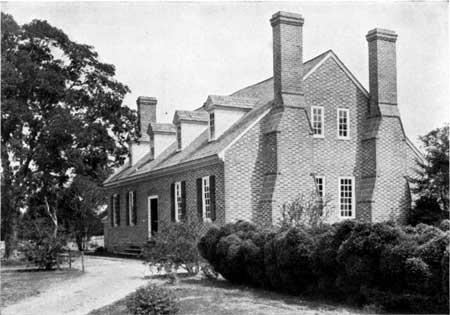MENU
|
Glimpses of Historical Areas East of the Mississippi River |
|
The Colonial Period |
|
VIRGINIA |
Special Feature: Birthplace of George Washington.

Wakefield House, George Washington Birthplace
National Monument.
(Photo by Grant)
GEORGE WASHINGTON Birthplace National Monument in Virginia was established January 23, 1930, by act of Congress. At that time approximately 12 acres of land in Federal ownership, including the site of the house in which George Washington was born and a granite shaft erected thereon by the Federal Government in 1896 marking that site, were turned over to the National Park Service by the War Department. Subsequent gifts of land have been made to the Federal Government by the Wakefield National Memorial Association, the Washington heirs, the State of Virginia, and John D. Rockefeller, Jr. The monument now contains 394.47 acres.
The original Popes Creek House. — This house, which later came to be known as "Wakefield" and in which George Washington was born in 1732, was built by his father, Augustine, about 1725. Augustine Washington purchased the property on Popes Creek in 1718, adding it to the Bridges Creek Plantation, which had been established by Col. John Washington, founder of the Washington line in America. This John Washington, the great-grandfather of George Washington, came to Virginia in 1657 and had an interesting career as soldier, legislator, and farmer.
The Popes Creek House and Bridges Creek plantation were inherited by Augustine, Jr., George's older half-brother, in 1743. He died in 1762, and these properties were then bequeathed to his son William Augustine Washington. On Christmas Day 1780 the Popes Creek House was destroyed by fire.
William Augustine Washington died in 1810, bequeathing the site of the Popes Creek House, as the "Burnt House Plantation", to his son George Corbin Washington, who 3 years later sold it to one John Gray, but reserved a plot 60 feet square containing the actual house site, and also the family burial plot a mile west at Bridges Creek.
In the year 1815 an inscribed stone was placed by George Washington Parke Custis at the corner of the ruins of the old house to indicate the exact site at which George Washington was born. Mr. Custis, a grandson of Martha Washington, was adopted and raised from infancy by George and Martha Washington.
In the year 1882 this historic plot was given to the Federal Government through deeds of conveyance from the State of Virginia and the Washington heirs. On July 10, 1883, the Federal Government purchased from the Washington heirs an additional area of approximately 12 acres surrounding the plot, together with necessary land for an entrance road from a proposed pier near Bridges Creek. In 1896 the erection of a 50-foot granite shaft to replace the Custis stone was made possible by a congressional appropriation. This shaft was moved to its present location at the entrance to the monument grounds in 1930, at the time of the reconstruction of the Wakefield House.
The present house and grounds. — When the national monument was established, the National Park Service and the Wakefield National Memorial Association, with the aid of a congressional appropriation, erected the present birthplace house upon the site of the old foundations. Although years of research failed to produce an authentic picture of the original house, enough of the original foundations remained to indicate its size, orientation, and character. Also, the tradition is that the old Christian family home in Providence Forge, Va., which is still standing, once was referred to as similar to the birthplace house by Col. Burgess Ball, a cousin of George Washington. This evidence and many other bits of information all were used by the architect for the Wakefield National Memorial Association in designing the present structure, which was built in 1930-31. All the bricks in the new building were made by hand and burned within a hundred yards of the site.
A frame kitchen building approximately 50 feet to the rear of the birthplace house stands on the site of the ancient kitchen, and there is also an interesting collection of valuable relics on display there. The superintendent's office is located temporarily in this building.
A brick walk, bordered by boxwood hedges, leads to the restored garden, where the visitor may view a display of herbs and plants such as were cultivated 200 years ago. The boxwood hedges originally were planted by Sarah Tayloe Washington at "Campbellton", some 6 miles distant, and are said to be more than a century old. She was a daughter of William Augustine Washington, the last occupant of the original Wakefield House. The grove of cedar trees has sprung up since the Federal Government acquired the site in 1882, and it is probable that the veteran hackberry tree near the rear door of the Wakefield House is a sprout from a tree that was burned along with the original house in 1780. Between the house and the kitchen there are several fig bushes which are original plants, their root systems having survived since the days of the Washington occupancy.
The Washington family burial ground, one of the interesting features of the monument area, is located 1 mile west of the Monument Circle near the mouth of Bridges Creek. Here are buried a number of early members of the Washington family, including George's father, grandfather, and great grandfather.
NEXT> Fort Necessity National Battlefield Site
 Top
Top
Last Modified: Thurs, Nov 23 2000 10:00:00 pm PDT
http://www.cr.nps.gov/history/online_books/glimpses3/glimpses1d.htm
![]()
